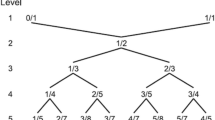Abstract
The dynamics of coupled biological oscillators can be modeled by averaging the effects of coupling over each oscillatory cycle so that the coupling depends on the phase difference φ between the two oscillators and not on their specific states. Average phase difference theory claims that mode locking phenomena can be predicted by the average effects of the coupling influences. As a starting point for both empirical and theoretical investigations, Rand et al. (1988) have proposed dφ/dt=Δω — K sin φ), with phase-locked solutions φ=arcsin(Δω /K), where Δω is the difference between the uncoupled frequencies and K is the coupling strength. Phase-locking was evaluated in three experiments using an interlimb coordination paradigm in which a person oscillates hand-held pendulums.Δω was controlled through length differences in the left and right pendulums. The coupled frequency ωc was varied by a metronome, and scaled to the eigenfrequency ωv of the coupled system K was assumed to vary inversely with ωc. The results indicate that: (1) Δω and K contribute multiplicatively to φ (2) φ =0 or φ = π regardless of K when Δω=0; (3) φ ≈ 0 or φ ≈ π regardless of Δω when K is large (relative to Δω); (4) results (1) to (3) hold identically for both in phase and antiphase coordination. The results also indicate that the relevant frequency is ωc/ωv rather than ωc. Discussion high-lighted the significance of confirming φ=arcsin(Δω/K) for more general treatments of phase-locking, such as circle map dynamics, and for the 1∶1 phase-entrainment which characterizes biological movement systems.
Similar content being viewed by others
References
Arnold VI (1965) Small denominators. I. Mapping of the circumference onto itself. Am Math Soc Translat 46:213–284
Baker GL, Gollub JP (1990) Chaotic dynamics: an introduction. Cambridge University Press, Cambridge
Bingham G, Schmidt RC, Turvey MT, Rosenblum L (1991) Task dynamics and resource dynamics in the assembly of a coordinated rhythmic activity. J Exp Psychol; Hum Perc Perf 17:359–381
Den Hartog JP (1948) Mechanics. Dover, New York
Glass L, Mackey MC (1988) From clocks to chaos: The rhythms of life. Princeton University Press, Princeton, NJ
Grillner S (1981) Control of locomotion in bipeds, tetrapods, and fish. In: Brooks VB (ed) Handbook of physiology, Sect 1: The nervous system; Vol II, Part 2. Am Physiol Soc, Bethesda, MD, pp 1179–1236
Haken H, Kelso JAS, Bunz H (1985) A theoretical model of phase transitions in human hand movements. Biol Cybern 51:347–356
Jackson EA (1989) Perspectives of nonlinear dynamics. Cambridge University Press, Cambridge
Kelso JAS, DeGuzman GC, Holroyd T (1990) The self organized phase attractive dynamics of coordination. In: Babloyantz A (ed) Self organization, emerging properties and learning. Plenum Press, New York, pp 41–62
Kelso JAS, Scholz JP, Schöner G (1986) Nonequilibrium phase transitions in coordinated biological motion: Critical fluctuations. Phys Lett 118:279–284
Kopell N (1988a) Toward a theory of modelling central pattern generators. In: Cohen AH, Rossignol S, Grillner S (eds) Natural control of rhythmic movements in vertebrates. Wiley, New York, pp 369–413
Kopell N (1988b) Chains of oscillators and the effects of multiple couplings. In: Kelso JAS, Mandell AJ, Schlesinger MF (eds) Dynamic patterns in complex systems. World Scientific, Singapore, pp 156–161
Kugler PN, Turvey MT (1987) Information, natural law and the self-assembly of rhythmic movement. Erlbaum, Hillsdale, NJ
Murray JD (1990) Mathematical biology. Springer, Berlin Helidelberg New York
Rand RH, Cohen AH, Holmes PJ (1988) Systems of coupled oscillators as models of central pattern generators. In: Cohen AH, Rossignol S, Grillner S (eds) Neural control of rhythmic movements in vertebrates. Wiley, New York, pp 333–367
Rosenblum LD, Turvey MT (1988) Maintenance tendency in coordinated rhythmic movements: Relative fluctuations and phase. Neuroscience 27:289–300
Schmidt RC Spatio-temporal patterns in interpersonal coordination (submitted for publication)
Schmidt RC, Beek PJ, Treffner PJ, Turvey MT (1991) Dynamical substructure of coordinated rhythmic movements. J Exp Psychol; Hum Perc Perf 17:635–651
Schmidt RC, Carello C, Turvey MT (1990) Phase transitions and critical fluctuations in the visual coordination of rhythmic movements between people. J Exp Psychol; Hum Perc Perf 16: 227–247
Schmidt, RC, Shaw BS, Turvey MT (in press) Coupling dynamics in interlimb coordination. J Exp Psychol; Hum Perc Perf
Stein PSG (1973) The relationship of interlimb phase to oscillator activity gradients in crayfish. In: Stein RB, Pearson KG, Smith RS, Redford JB (eds) Control of posture and locomotion. Plenum Press, New York, pp 621–623
Stein PSG (1974) The neural control of interappendage phase during locomotion. Am Zool 14: 1003–1016
Turvey MT, Rosenblum LD, Schmidt RC, Kugler PN (1986) Fluctuations and phase symmetry in coordinated rhythmic movements. J Exp Psychol; Hum Perc Perf 12:564–583
Turvey MT, Schmidt RC, Beek PJ (in press) Fluctuations in interlimb rhythmic coordinations. In: Newell K, Corcas D (eds) Variability in motor control. Human Kinetics, Champaigne
Turvey MT, Schmidt RC, Rosenblum LD, Kugler PN (1988) On the ime allometry of coordinated rhythmic movements. J Theor Biol 130: 285–325
von Holst E (1937/1973) On the nature and order of the central nervous system. In Martin R (ed and trans) The collected papers of Erich von Holst: vol. 1. The behavioral physiology of animal and man. University of Miami Press, Coral Gables
Author information
Authors and Affiliations
Rights and permissions
About this article
Cite this article
Sternad, D., Turvey, M.T. & Schmidt, R.C. Average phase difference theory and 1∶1 phase entrainment in interlimb coordination. Biol. Cybern. 67, 223–231 (1992). https://doi.org/10.1007/BF00204395
Received:
Accepted:
Issue Date:
DOI: https://doi.org/10.1007/BF00204395




